

Easy Wi-Fi 6
Get a comprehensive set of wireless features, with one 4x4 2.4GHz radio and one 8x8 5GHz Wi-Fi 6 (802.11ax) radio, delivering a raw capacity of 4.8 Gigabits.



Get a comprehensive set of wireless features, with one 4x4 2.4GHz radio and one 8x8 5GHz Wi-Fi 6 (802.11ax) radio, delivering a raw capacity of 4.8 Gigabits.
Secure WAN
Use the TQ6702 GEN2-R as a secure gateway, with a firewall to protect Internet connectivity and highly-secure VPNs for connections back to a central office or other sites.
Simplify business networks and reduce overheads with our comprehensive all-in-one Wi-Fi 6 Access Point and Secure VPN Router.
Are you a small business, or an enterprise with multiple locations, such as retail stores, cafes, and more? High-performing Wi-Fi is essential for businesses like yours –as are high security, easy deployment, and cost-effectiveness.
The TQ6702 GEN2-R offers what you need: a simple, comprehensive network solution in a single stylish device, with high-speed Wi-Fi 6 connectivity for wireless devices, and a secure Internet connection from the built-in VPN router.
With this TQ Series all you need is a single device to provide seamless wireless access and secure connectivity to the Internet.
For
information, please contact
www.cxoinsightme.com
26 CONTEXT MEETS CULTURE
Amazon.com’s Werner Vogels explains why cloud is the foundation—but culture and context will define AI’s future
44 DRIVING GLOBAL CYBER GROWTH
Dell Technologies’ Mohammad Amin on the region’s AI momentum, purposeful adoption, and responsible innovation
48 BEYOND THE BUILD AVEVA on how digital transformation unlocks agility and efficiency for EPC firms
52 DERISKING CORE MODERNISATION
Endava highlights that, with the right strategy, modernisation can drive real value without compromising business continuity
58 The latest gears and gadgets to keep you ahead of the curve
Recorded Future’s Wajdi Khalid on why threat intelligence is key to turning data into actionable defence—and driving resilience









momentum. And in the Middle East, that momentum is
We’ve seen landmark announcements in the region’s tech landscape. Saudi Arabia unveiled HUMAIN, its national AI venture, backed by a $10 billion fund and tech deals worth $23 billion with the likes of NVIDIA, AMD, Cisco, Qualcomm, and AWS—marking the Kingdom’s latest
Meanwhile, the UAE continues to raise the bar with the launch of Stargate UAE—a bold initiative to build one of the world’s largest AI supercomputing hubs. With 1 gigawatt of computing power planned and partnerships spanning OpenAI, G42, Oracle, and more, it reflects the country’s vision to lead in AI infrastructure and sovereign capability. These developments underscore the region’s
controversy— ranging from inflated claims to internal our race to innovate, we must prioritise trust. Progress
That’s the lens we’ve taken for this issue. Our cover story spotlights Wajdi Khalid of Recorded Future, who offers
must move from passive data collection to strategic decision-making. He explains how real-time, contextual intelligence helps organisations in the Middle East detect adversaries faster, reduce alert fatigue, and respond with precision.
We also feature insights from global leaders— Amazon CTO Werner Vogels on why AI must reflect culture and context, and Dell’s Mohammad Amin on anchoring regional AI growth in responsibility. Plus, AVEVA and Endava share strategies for building agility, resilience, and lasting value.
And don’t miss our celebration of this year’s Cyber Strategists’ Summit Award winners—turn to page 32.
As we look ahead, we need to stay grounded and remember that lasting innovation isn’t about speed— it’s about moving forward with purpose, responsibility, and impact.
Happy reading!
Adelle Geronimo
Managing Editor
Commercial Director
Merle Carrasco
merlec@insightmediame.com
+97155 - 1181730
Administration Manager Fahida Afaf Bangod fahidaa@insightmediame.com +97156 - 5741456
Operations Director
Rajeesh Nair
rajeeshm@insightmediame.com +97155 - 9383094
Designer Anup Sathyan
While the publisher has made all efforts to ensure the accuracy of information in this magazine, they will not be held responsible for any errors

Since its launch in January 2022, the UAE Verify platform— operated by the TDRA—has issued nearly 22 million certified digital documents for 55 document types across 22 federal and local entities. Leveraging blockchain, it enables instant, secure verification without physical copies, reinforcing the UAE’s digital transformation efforts.
biggest bet yet

OpenAI has acquired io, the AI hardware startup founded by ex-Apple designer Jony Ive, in a $6.5 billion stock deal— its largest acquisition to date. The move brings over 50 design experts into a new division focused on creating an AI-first consumer device, slated for launch in 2026. A trademark dispute has clouded the branding.
names first CDAO

EDGE challenges the world to rethink drone systems

EDGE Group has teamed up with Wazoku to launch a Global Drone in a Box Innovation Challenge, inviting worldwide innovators, startups, universities, and established firms to develop fully autonomous UAV systems— drones with docking/charging stations, ground control, and software—for defense and security applications. Submissions are due July 7, 2025, and the total prize fund is $20,000 ($15K for the winner, $5K for runner up)

Apple unveiled its most significant software redesign in over a decade at WWDC 2025, introducing Liquid Glass—a dynamic, translucent UI material spanning iOS 26, iPadOS 26, macOS Tahoe 26, watchOS 26, and tvOS 26. The new interface adapts to light, movement, and context, enhancing depth and clarity across system elements and apps while unifying design across platforms.
Gigamon expands EMEA Focus with new leadership
JAGGAER has appointed Gopinath “GP” Polavarapu as its first Chief Digital & AI Officer (CDAO), ushering in a new era of Agentic AI across its One platform. Polavarapu will lead the development of autonomous workflows and establish an AI Centre of Excellence to drive innovation and efficiency.

Gigamon has named Damian Wilk as General Manager for EMEA Emerging Markets, based in Dubai. He’ll oversee growth across the Middle East, Africa, and Southern Europe, targeting hybrid-cloud security and deep observability.


Saudi Arabia has launched HUMAIN, a new artificial intelligence company backed by the Public Investment Fund (PIF), marking a major milestone in the Kingdom’s ambitions to become a global leader in AI innovation.
HUMAIN aims to localise advanced AI capabilities, build sovereign infrastructure, and accelerate the country’s transformation into a global digital powerhouse aligned with Vision 2030.
The company is spearheaded by Tareq Amin, formerly of Rakuten and NEOM, and has been tasked with overseeing the design, deployment, and development of AI factories, sovereign cloud platforms, and large-scale language models tailored to Arabic and Islamic contexts. HUMAIN has set a bold target to handle seven percent of global AI workloads by 2030 and build up to 6.6 GW of data centre capacity across the Kingdom.
At launch, HUMAIN revealed a series of high-impact partnerships with major global technology companies. NVIDIA has partnered with HUMAIN to establish
hyperscale “AI factories” in the Kingdom, beginning with an initial deployment of 18,000 Blackwell GPUs. These facilities will support AI model training, simulation, and digital twin development for industries like logistics, energy, and manufacturing.
In parallel, AMD committed to a multiyear, $10 billion agreement to supply GPU and CPU infrastructure, matching the 500 MW compute capacity goal set by the NVIDIA collaboration. AWS also entered the fold with a $5 billion investment to build a new AI cloud region in Saudi Arabia and a GenAI Innovation Centre, including a commitment to train 100,000 Saudis in AI and cloud technologies.
Cisco will provide AI-ready infrastructure, cybersecurity platforms, and training for half a million learners, while Qualcomm is working with HUMAIN on advanced data centre and edge-to-cloud architectures, including a semiconductor design centre in Riyadh.
Adding to the ecosystem, coding platform Replit announced a partnership with HUMAIN to localize its AI coding

agents in Arabic and integrate them into HUMAIN Cloud. The goal is to democratize access to AI-powered coding tools for students, developers, and enterprises across the region.
HUMAIN’s launch signals a new era of sovereign AI infrastructure, regional innovation, and deep public-private collaboration—positioning Saudi Arabia as a serious contender in the global AI arena.
Redefining Cybersecurity Talent Through a Skills-First Approach
The cybersecurity workforce challenge isn’t just about hiring more people, it’s about finding, developing, and retaining the right talent with the right skills. The 2025 Cybersecurity Workforce Research Report brings insights from 3,400+ cybersecurity and HR leaders, alongside real-world case studies from top organizations showcasing successful hiring, training, and retention strategies.
Upskilling Often Overrides Hiring

of organizations prefer to upskill and cross-train their workforce rather than rely on external hiring
There Are Skills Gaps to Address, Not Headcount Shortages
HR and Cybersecurity Teams Are Aligning on the Priority of Cyber Talent
Companies Are Investing in their Future Through Training and Certification
of organizations cite “not having the right staff” as their biggest concern—rather than just a lack of personnel
of HR managers now spend more than half their time focused specifically on cybersecurity staffing, indicating growing specialization within HR teams

of organizations now invest in formal cybersecurity training programs
IBM has announced plans to build a practical quantum computer by 2029, aiming to overcome one of the field’s biggest hurdles: error correction. The company will develop a system named Starling, expected to feature around 200 logical qubits—enough to demonstrate performance advantages over classical computers.
To be housed in a new data centre in Poughkeepsie, New York, Starling is part of IBM’s broader roadmap, which includes scaling to even larger quantum systems by 2033. Unlike previous approaches, IBM’s researchers designed error-correction methods based on chips that are feasible to build, enabling more efficient use of qubits.

IBM joins other tech giants such as Microsoft, Google, and Amazon in the race toward usable quantum computing. The company believes its latest algorithm drastically

The UAE has announced Stargate UAE, a large-scale artificial intelligence infrastructure cluster to be built in Abu Dhabi as part of a broader partnership between Emirati and American technology firms.
The project will be located at the newly established UAE–US AI Campus and will span 10 square miles. It will eventually offer 5 gigawatts of power, sourced from nuclear, solar, and natural gas, making it the largest AI infrastructure site outside the United States.
The initiative is being led by G42 and developed in collaboration with OpenAI and Oracle, with Cisco providing networking systems and NVIDIA supplying its Grace Blackwell GB300 compute platforms. SoftBank Group is also backing the project as part of its global investment in AI infrastructure.
Peng Xiao, Group CEO of G42, said, “The launch of Stargate UAE is a significant step in the UAE–US AI partnership. As a founding partner, we’re proud to work alongside institutions that share our belief in responsible innovation
reduces the number of qubits needed for error correction, paving the way for engineering-focused development rather than scientific reinvention.
This initiative is about building a bridge - rooted in trust and ambition - that helps bring the benefits of AI to economies, societies, and people around the world
PENG XIAO G42
and meaningful global progress. This initiative is about building a bridgerooted in trust and ambition - that helps bring the benefits of AI to economies, societies, and people around the world.”
The first phase—a 200-megawatt compute cluster—is expected to be operational by 2026. Once complete, Stargate UAE will serve as a key regional hub for AI workloads across industries including healthcare, energy, finance, and logistics.
Stargate UAE is part of the broader US-UAE AI Acceleration Partnership, which also includes plans to expand Emirati investment in AI infrastructure within the United States. The initiative reflects growing global interest in national-scale AI capabilities.
Qatar’s Ministry of Commerce and Industry (MoCI) has launched two new AI-powered virtual assistants—Smart Assistant and Saif—in collaboration with Microsoft, marking a significant step forward in the country’s digital transformation agenda.
The Smart Assistant, now available on the Single Window platform, is designed to guide users through government procedures with real-time, step-by-step assistance. It operates 24/7 and aims to reduce reliance on staff by enabling users to complete transactions independently. Speaking at the launch, Mubarak Alkhelaifi, Director of the Single Window Department, said the tool will improve both efficiency and service continuity.
Meanwhile, Saif is accessible through the Ministry’s website and mobile app. Developed using advanced AI technologies, it provides users with an intuitive interface to access information and complete services with ease. Ahmad Al-Kuwari, Director of the IT Department, described Saif as a key enhancement to the Ministry’s digital offerings.
Both tools reflect MoCI’s broader objective to modernise its digital infrastructure and set a new standard for smart public services in Qatar.
Space42 has opened the Middle East and North Africa’s first High-Altitude Platform Stations (HAPS) manufacturing facility in Abu Dhabi. Operated through its subsidiary Mira Aerospace, the

4,500-square-metre plant is capable of producing more than 20 high-end unmanned aerial vehicles (UAVs) annually.
The new facility is part of the UAE’s broader push to develop sovereign capabilities in aerospace and aligns with the National Space Strategy 2030. These high-altitude UAVs are designed for a range of uses, including environmental monitoring, emergency response, and defence operations.

The decision to build our new HAPS manufacturing facility in Abu Dhabi reflects our commitment to creating reliable, cost-effective systems with advanced space technology…
Khaled Al Marzooqi, CEO of Mira Aerospace, Space42, said, “As the global demand for HAPS accelerates, Space42 is making strategic investments to strengthen our leadership in this growing market. The decision to build our new HAPS manufacturing facility in Abu Dhabi reflects our commitment to creating reliable, cost-effective systems with advanced space technology and plays a central role in developing sovereign capabilities that support our long-term business objectives and the UAE’s broader economic goals.”
Space42 is expanding through global partnerships, co-producing Earth observation satellites with ICEYE and setting up a HAPS testing hub with XRANGE. It also recently demonstrated 5G connectivity from the stratosphere, boosting the UAE’s aerospace ambitions.

“AI IS THE FUTURE OF DATA, BUSINESS, AND OUR LIVES…WE’RE CREATING A FUTURE WHERE INTELLIGENCE AMPLIFIES HUMAN POTENTIAL ON A MASSIVE SCALE”
Michael Dell, Chairman and CEO, Dell Technologies

“WE ARE DEMOCRATISING AI AT THE COMPUTE LEVEL, ENSURING THAT ACCESS TO ADVANCED AI IS LIMITED ONLY BY IMAGINATION, NOT BY INFRASTRUCTURE”
Cybersecurity is entering an era where speed, scale, and intelligence are no longer optional. That’s the key insight from Positive Technologies’ new report, which finds that 55 percent of cybersecurity countermeasures in the MITRE D3FEND matrix can now be supported by advanced automation—28 percent already are, with another 27 percent on the way.
The value proposition is hard to ignore. Tools such as MaxPatrol SIEM and PT Sandbox use behavioural analysis to uncover zero-day threats, while MaxPatrol O2 has demonstrated the ability to detect and stop attacks autonomously—most notably during the Standoff 13 cyber exercise. According to IBM, organisations leveraging AI in cybersecurity saved an average of $2.2 million in breach-related costs, highlighting the tangible benefits of these technologies.
But as adoption accelerates, so too do the concerns. A Bugcrowd survey found that 93 percent of ethical hackers believe integrating AI into business environments introduces new attack vectors. The complexity of these systems, combined with a lack of proper oversight, could inadvertently create fresh vulnerabilities. Meanwhile, the stakes continue to rise: in some regions, cyber incidents surged by 260 percent year-on-year in Q2 2024—a stark reminder of the threat landscape’s volatility.
The report urges a balanced approach. While intelligent automation offers scale, speed, and efficiency, it must be deployed responsibly. That means quality training data, transparent models, and skilled human oversight. AI may be driving the future of cybersecurity—but trust, governance, and vigilance are what will ultimately secure it.
The average breach cost reduction for companies using AI in security operation 93%
The proportion of ethical hackers who believe AI integration creates new attack vectors
$2.2M
Source:IBM



Wajdi Khalid , Head of Regional Sales, Recorded Future, discusses why organisations across the region should embrace threat intelligence as a critical layer of defence—turning data into actionable insights that power resilience
Can you give us an overview of Recorded Future’s presence in the Middle East? Where are you seeing the strongest demand, and which sectors are driving adoption?
Recorded Future has been present in the Middle East region for the past eight years, with a team of over 30 employees providing services to more than 150 active clients, with offices in Dubai and Riyadh.
As the threat landscape becomes more complex and persistent, threat intelligence is no longer a nice-to-have solution—it has become a critical component of any security operation centre. It enables organisations to proactively mitigate risks and investigate threats to stay ahead of an increasingly complex and evolving threat landscape. This shift in mindset is directly driving demand for our offerings.
We have seen strong demand across all sectors, with the BFSI and public sector driving the largest adoption, given their heightened risk exposure and regulatory requirements.
What threat trends and adversaries are most active in the region right now, and how is Recorded Future helping organisations address these evolving risks?
In the Middle East, we’re observing a range of evolving threat trends and adversarial activities that are shaping the regional cybersecurity landscape. One of the most prominent is influence operations, particularly by Iranian-linked actors. These groups are leveraging inauthentic websites and social media accounts to spread propaganda and push specific narratives, especially around regional tensions.
Cyber-espionage remains a significant concern, with groups like Stealth Falcon exploiting vulnerabilities—such as the recently disclosed zero-day CVE-202533053—in targeted campaigns against government and defence sectors in several Middle Eastern countries. There has also been a noticeable uptick in cybercriminal and

hacktivist activity, much of it tied to geopolitical flashpoints involving NATO and ongoing regional conflicts. These campaigns are often ideologically driven or financially motivated.
The escalating conflict between Iran and Israel has further intensified the cyber threat landscape, with military actions mirrored by increased cyber offensives and retaliatory attacks.
Key adversaries include Stealth Falcon, known for its targeted
espionage campaigns; and the Handala Hack Team, which is affiliated with Iranian intelligencelinked groups..
To help organisations address these evolving risks, Recorded Future delivers real-time, actionable threat intelligence—both cyber and physical—that enables security teams to detect, prioritise, and respond to threats proactively. We help organisations quickly connect the dots between threat actors, their tools, tactics and procedures, and

their targets, helping security teams neutralise critical threats before they happen.
We index intelligence from over one million global sources, enriched by expert analysis from our research division, Insikt Group, to provide comprehensive and contextual coverage of the threat landscape.
Threat intelligence has evolved significantly—what’s driving its shift from a supplementary
tool to a core component of cybersecurity strategy?
Threat intelligence has become a critical tool for helping organisations defend against imminent threats and anticipate future security impacts. As the attack surface continues to expand rapidly and threat actors grow increasingly unrestrained, security teams need actionable intelligence to prepare and respond before threats reach their doorstep. With the exponential growth of cloud-based platforms, SaaS
One of the most common challenges we see from customers looking to improve how they operationalise threat intelligence is that their previous intelligence wasn’t actionable enough
applications, connected devices, and AI technologies, tech stacks are becoming larger and more complex. This leads to more data, more blind spots, and greater challenges for security teams—many of which are still viewed as cost centers rather than business enablers. Threat intelligence helps improve visibility across the attack surface, enabling organisations to identify what exposures threat actors are most likely to exploit and where their vulnerabilities lie.
Additionally, threat actors are becoming more motivated and unrestrained. Today’s adversaries operate globally, unhindered by jurisdictional laws, and are driven by financial, geopolitical, and other motivations. They have more resources than ever, and their operations are increasingly fuelled by AI. Their greatest advantage is that they only need to succeed once, while security teams—often working with limited resources— must succeed every time. With
professionals should start with strategic threat intelligence to establish a bigpicture view

threat intelligence, organisations can stay ahead of today’s fast-moving attackers by better understanding their motivations and infrastructure, and preparing their defences accordingly.
What are the common challenges in operationalising TI, and how does Recorded Future help bridge the gap between raw data and actionable insight?
One of the most common challenges we see from customers looking to improve how they operationalise threat intelligence is that their
previous intelligence wasn’t actionable enough. It often included too much noise, lacked context, and wasn’t specific to their organisation’s needs.
Recorded Future is powered by our Intelligence Graph. We collect data from over one million sources across the open web (including news, forums, and social media—essentially anything accessible on the internet), as well as from technical sources such as network intelligence, sandbox detonations, vulnerability data, malware intelligence, the dark web, our world-class research division—the Insikt Group—thirdparty feeds (e.g. ISAC feeds), and customer telemetry from security tools like CrowdStrike, SentinelOne, Splunk, and others. All of this is done automatically, in real time, and across multiple languages.
The Intelligence Graph uses advanced analytics and AI to organise and normalise these massive data sets into relevant, actionable insights. These insights are delivered through our products, integrations, and APIs, enabling customers to easily transform raw data into meaningful intelligence they can act on.
How are you enabling security teams at different maturity levels to fully utilise threat intelligence?
Each security team we work with is at a different stage in their threat intelligence maturity, and our goal is to help them get the most value out of their investment in Recorded Future. To support this, we offer a range of services tailored to their needs and capabilities.
Our Analyst on Demand service connects clients with our global network of intelligence professionals who provide custom reporting, deep technical analysis, and assessments of cyber and geopolitical trends. This ensures that organisations have direct access to expert insights to support their decision-making. For teams that need more handson support, we offer Managed Monitoring, where Recorded Future experts act as an extension of the organisation’s security team. This approach helps customers grow and

mature their security programmes regardless of their current capacity or maturity level.
Additionally, our Intelligence Services team delivers customised solutions designed to optimise intelligence workflows and enhance the overall effectiveness of an organisation’s security investment. This includes tailored enablement workshops, technology stack integrations, bespoke engagements, and data enrichment to support operational needs.
By offering flexible, expert-led services, we ensure that security teams—no matter their maturity level—can fully operationalise threat intelligence and strengthen their security posture.

There’s often a debate between investing in tactical versus strategic TI. How should security leaders in the region strike the right balance?
Security leaders should approach the tactical versus strategic threat intelligence investment balance through a structured, businessaligned strategy that recognises both their complementary nature and distinct value propositions.
Security professionals should start with strategic threat intelligence to establish a big-picture view. Without this high-level understanding, organisations often end up in a reactive cybersecurity stance, chasing everything that looks like a high risk that becomes a cycle that
never ends. A security programme driven by strategic threat intelligence is more proactive and helps the business make more informed riskbased decisions.
While tactical threat intelligence is important and provides specifics around technical aspects of attacks, it shouldn’t be where organisations start nor it should be the only type of intelligence they use. The approach should establish formal intelligence programmes that allow tactical, operational, and strategic intelligence to be properly consumed, processed, analysed, and delivered to appropriate users.
With AI accelerating both cyberattacks and defence, how is
Recorded Future integrating AI and ML into its Intelligence Cloud to stay ahead of advanced threats?
Recorded Future has long integrated AI into its core platform, particularly through our Intelligence GraphTM, which leverages machine learning to organise and contextualise massive volumes of threat data. More recently, we’ve extended these capabilities with generative AI through Recorded Future AI, designed to help users analyse and report on emerging threats more efficiently.
One way we’re enabling this is through AI Sessions, which allow analysts to interact with the Intelligence Graph using natural language. This makes it easier to automate analysis and generate intelligence, helping reduce the impact of the security talent gap by enabling teams to turn data into actionable insights with greater confidence and speed.
In addition, Recorded Future AI enhances the intelligence cycle by streamlining both the analysis and reporting process. It enables automated report creation, making it easier to share intelligence across teams and stakeholders, and helping organisations focus their efforts on critical decisions and proactive defence.
Finally, AI also plays a key role in expanding threat coverage. By analysing vast datasets in real time, Recorded Future AI identifies key connections, emerging risks, and relevant context tailored to each organisation. The result is faster, more effective responses, supported by prioritised alerts and clear, contextual intelligence.
Looking ahead, what are your strategic priorities for the Middle East?
Our strategic priority in the region is to continue expanding and replicating the success we’ve had in Saudi Arabia across the rest of the Middle East. In particular, we aim to stay aligned with the local regulations and compliance requirements issued by national CERTs, cybersecurity authorities, and central banks. Additionally, we are focusing on expanding our coverage of threat actors targeting the region.
At Dell Technologies World 2025 in Las Vegas, the company laid out a bold vision for the future of enterprise AI, edge computing, and intelligent infrastructure— signalling a major shift in how businesses will harness data and innovation at scale
“ AI is the future of data, business, and our lives,” Michael Dell, founder and CEO of Dell Technologies, declared in his keynote address from the symbolic “Dell Technologies Way,” which he dubbed the crossroads of innovation. He emphasised this point by stating, “Data is at the centre of everything— everywhere, all the time,” Dell said. “Soon, over 75 percent of enterprise data will be created and processed at the edge. And AI will follow the data, not the other way around.”
Dell then highlighted how AI is already being implemented at the edge across sectors such as retail, healthcare, and industry. He showcased Dell’s role in driving this shift, underpinned by high-density, high-efficiency infrastructure, and real-world deployments. A notable example was the Colossus supercomputer, developed by xAI, featuring 110,000 GPUs, 27,500 GPU nodes, 2,800 racks, 6,000 switches, and 27,000 miles of cabling. “From a blank sheet of paper to full operational capacity in weeks—this is high-efficiency infrastructure, built to scale,” Dell said.
But he added, “You don’t need your own Colossus—but you do need AI. And we’re taking all the learnings from these massive systems to make AI easy for you, from AI PCs to small, domain-specific models running on the edge to the planetary-scale AI data centres.”
Last year, the company introduced the Dell AI Factory, a program aimed at providing enterprises the hardware they need to quickly design and manage their AI infrastructures,
AI is the new electricity and Dell is the grid powering this transformation— connecting the data, the intelligence, and the innovation
with more than 3,000 being deploy since then. According to the, the Dell founder the AI Factory was 60 percent more cost-efficient than public clouds.
Further into his keynote, Dell also spotlighted how enterprises are putting this vision into action. Larry Feinsmith, Head of Global Technology Strategy, Innovation & Partnerships at JPMorgan Chase, discussed how the financial giant is embedding AI across its global operations. With an $18 billion investment in technology this year, JPMorgan has launched its proprietary generative AI platform, LLM Suite, for over 200,000 employees. “We believe this is the largest enterprise rollout of a generative AI application,” said Feinsmith, adding that the next

frontier lies in agentic AI—models that can think, plan, and execute complex business processes end to end.
Seemantini Godbole, Chief Digital and Information Officer of Lowe’s, shared how the company has transformed following a digital reinvention that began after a Black Friday website crash in 2018. Now, AI is deployed to over 300,000 associates across 1,700 stores, powered by Dell PowerEdge servers and NVIDIA L4 GPUs delivering real-time inferencing at the edge. Lowe’s has also introduced a GenAI assistant dubbed “ChatGPT for

Home Improvement,” aimed at enabling any associate to answer customer questions confidently. “Our goal is to make every associate a ‘super associate,’” she said.
On the same day, Dell expanded on its AI commitment in a compelling segment featuring NVIDIA CEO Jensen Huang. Together, they unveiled the Dell AI Factory with NVIDIA 2.0—a next-generation platform designed to democratise AI access for enterprises of all sizes. This milestone represents a deepening of Dell’s long-standing partnership
with NVIDIA and their shared goal of tackling what they described as the “biggest reinvention in 60 years of computing.”
Dell introduced new AI-optimised PowerEdge servers, the XE9680L and XE9680XL, equipped with eight NVIDIA B100 Tensor Core GPUs, delivering up to four times faster LLM training and eleven times the compute performance for inference. These high-density systems can support up to 256 GPUs per rack. Alongside them, Dell launched the PowerCool rear-door heat exchanger, capable of capturing
nearly 100 percent of heat loads and reducing cooling costs by up to 60 percent.
Other highlights included enhancements to networking through NVIDIA X800 switches integrated into Dell PowerSwitch, Project Lightning—the world’s fastest parallel file system with double the throughput of competitors— and Dell ObjectScale with NVIDIA Spectrum-X for real-time, petabyte-scale data lakes. Dell also showcased a 100x increase in tokens per second for distributed inferencing, coupled with an 80%


reduction in latency, making it ideal for agentic AI use cases.
decisively. “This is a once-in-alifetime opportunity. You don’t want to be second. This is how you want to be first.”
While much of the conversation focused on large-scale enterprise transformation, Dell also highlighted AI’s potential to impact individual lives. He cited Adrian Guan, an Australian entrepreneur who built Norby, a conversational AI robot designed to support speech therapy and language learning in over 40 languages. Powered by Dell Precision workstations and NVIDIA AI, Norby serves as a testament to how innovation can be both personal and powerful.
AI will follow the data, not the other way around
In a pre-recorded fireside chat, Dell and Huang reflected on their three-decade journey through the PC revolution, the rise of the internet and cloud, and now AI.
“This is the single biggest platform shift. Every layer of the computing stack is being reinvented,” Huang said. He urged enterprises to act
“AI is the new electricity,” Dell concluded. “And Dell is the grid powering this transformation— connecting the data, the intelligence, and the innovation.” He reaffirmed the company’s purpose-driven mission: “At our core, we’re about solving the world’s toughest challenges and enabling human requirements. That’s happening every day—in labs, factories, boardrooms, and living rooms around the world. And it’s all happening right here on our street where ideas turn into actions.”





Werner Vogels, CTO, Amazon.com, unpacks why cloud laid the foundation— but culture and context must shape what comes next for AI

As enterprises race to embed artificial intelligence across their operations, the real question isn’t whether AI will change the way we work—but how we design systems that are scalable, responsible, and culturally relevant. For Werner Vogels, Chief Technology Officer at Amazon Web Services, the key isn’t to idealise AI, but to understand it as part of a larger, evolving architecture of innovation.
“AI—what used to be known as machine learning—is simply the tool we use to make sense of data and extract real insights,” Vogels says.
This distinction underpins AWS’s entire approach to AI and reframes the role of data and the cloud as critical enablers of today’s intelligent systems.
Without scalable, cost-effective access to storage and compute, the vast data foundations required for AI wouldn’t be feasible. “The shift really happened with the cloud,” Vogels explains. “Suddenly, storage became cheap, and companies could afford to keep all their data. But that created a new problem: how do you get insights from it? That’s where AI comes in.”
Vogels believes the journey to today’s AI-powered enterprises didn’t begin with ChatGPT or image generators—it began when cloud infrastructure made it viable to retain vast amounts of data without knowing in advance what questions it might answer. “In the ’90s, businesses were collecting data, but only if they knew what to ask,” he says. “Storage
was expensive, so you couldn’t keep everything.” With cloud, that changed. But with abundance came complexity, and AI became the tool to unlock meaning from data. Now, as organisations increasingly describe themselves as “AI-first,” cloud computing has become foundational to that shift. “Cloud is the ideal environment for AI training,” Vogels explains. “You need massive compute capacity during the training phase, which might last a few weeks or months. But once that’s done, you don’t need that level of infrastructure anymore. That’s where the cloud’s elasticity becomes crucial. Scaling up is important—but being able to scale down and stop paying for unused capacity is where real cost efficiency comes in.”
Despite the technological momentum, Vogels says the biggest barrier to AI adoption isn’t innovation—it’s skills. “The technology part isn’t the problem. The challenge is the skills gap,” he explains.
While AI tools have advanced rapidly, especially with the rise of conversational chatbots, applying them in complex enterprise environments requires much deeper expertise. “It might seem like anyone can use AI now,” Vogels explains. “But if you want to optimise a supply chain with it, you need people who truly understand the technology. Most students graduating even a year ago haven’t been trained on this.”
This isn’t a shortcoming of education, Vogels clarifies, but rather a sign of how quickly the field is moving. “I’ve always believed the role of universities is to teach students how to learn—not to finish learning. Especially in engineering, the real learning begins once you’re on the job,” he says.
At Amazon, he notes, it can take junior engineers up to a year before they become significant contributors.
Generative AI, however, is changing how quickly that learning curve can be overcome. “Before, junior engineers learned by sitting next to senior ones and asking questions. But if you asked the same question twice, the senior would get frustrated,” he says. “Now, with a generative AI assistant, you can ask those questions over and over—‘Why did they do this?’—and get an answer every time. It’s like having a mentor who never gets tired.”
Vogels also sees a massive opportunity to modernise legacy systems—millions of lines of business-critical code still run on outdated languages like COBOL and Fortran. “No one learns those in school anymore,” he says. “But with automation, we can translate them into modern programming environments, like serverless platforms on AWS, almost automatically.”
To support this transformation at scale, AWS is investing significantly in education. “We’ve committed to training over 700,000 people across Asia in AI and cloud technologies,” Vogels says. “Even the smartest students still need structured, continuous learning.”
For Vogels, responsible AI deployment starts with three key priorities: security, governance, and cost awareness. “Security will always be number one,” he says. “It’s where we invest the most—and always will.” Enterprises need to set strict guardrails around both the data being fed into models and the outputs being generated. Especially in high-stakes environments, hallucinations aren’t acceptable.
“You can’t afford hallucinations in enterprise applications,” Vogels notes. “You need to be able to say: this is what the system can do—and no more.” AWS addresses this with a technology called automated reasoning, a field of AI far more complex than generative models. “Automated reasoning lets you test all possible answers and reject what doesn’t make sense. That’s critical,” he explains.

It might seem like anyone can use AI now but if you want to optimise a supply chain with it, you need people who truly understand the technology
He also warns that too few companies are thinking clearly about cost. “In the early cloud days, innovation was more important than cost,” he says. “But eventually, people got serious about pricing. We want them to have that mindset now with AI—not five years later.”
With AI and cloud computing becoming critical parts of national strategies, data sovereignty and cloud resilience have become critical— especially in regions like the Middle East and North Africa. “Your data is your data,” Vogels emphasises. “We don’t own it. We don’t access it. And there are no backdoors.” AWS gives customers full control over their encryption keys. Even AWS engineers can’t access data unless explicitly granted access by the customer. “It’s not just about geopolitics. Encrypting your data is the best protection— always has been,” he says.
Sovereignty, however, is defined
differently in different regions. In Europe, AWS is building a sovereign cloud where only European citizens can operate the systems. In the United States, GovCloud ensures access is limited to US nationals. In the Middle East and North Africa, regionally hosted infrastructure combined with encryption-led controls helps customers meet local regulations and expectations. “It’s about giving customers tools, choice, and control,” Vogels says.
He adds that resilience is equally important. “Each AWS Region has at least three data centres. So even if one goes down, operations continue. That level of resilience is extremely hard to build on your own.”
Culturally intelligent AI
As AI systems become embedded in daily life, Vogels stresses the need for cultural context. “Simply translating a model doesn’t make it local,” he says. “A Western-trained LLM might suggest something that doesn’t align with local customs. An Arabic-language model wouldn’t—it understands the cultural context.”
AWS supports the development of culturally grounded models. In Saudi Arabia, for example, an LLM was trained entirely on Saudi text, enabling it to respond in ways aligned with local values and expressions. The Falcon model, developed by the UAE’s Technology Innovation Institute and hosted on AWS, was similarly designed to reflect the needs of Arabic-speaking users. In Southeast Asia, the SeaLLM model was trained on 11 regional languages to ensure local relevance across diverse populations.
“Localising language for LLMs doesn’t simply mean translating words—it’s about capturing culture, values, and context,” Vogels explains. “And some topics are talked about more—or less—in different cultures.” This is why localisation matters—not just for accuracy, but for respect and meaningful engagement. He envisions a future where diverse models coexist and learn from one another. “The future won’t be dominated by a single global model,” he says. “It will be shaped by many—each rooted in the culture it serves.”
Ahmed Sulaiman, Founder and CEO, Takween AI, shares how the company is building Saudi-first AI innovations
As Saudi Arabia fast-tracks its transformation into a knowledge-driven, digitally enabled economy, artificial intelligence (AI) has emerged as a pivotal pillar of its national strategy. In 2024, the government unveiled Project Transcendence, a $100 billion initiative focused on building a robust AI ecosystem—complete with advanced data centers, startup support frameworks, and nextgeneration infrastructure. The goal: to accelerate domestic growth and position the Kingdom as a global AI powerhouse.
This bold ambition builds on years of groundwork laid through Vision 2030, which places AI at the centre of Saudi Arabia’s economic diversification and technological innovation. From the formation of the Saudi Data and Artificial Intelligence Authority (SDAIA) to expansive smart city and digital infrastructure investments, the Kingdom is aligning regulation, talent, and technology to foster a thriving, sovereign AI ecosystem.
Among the standout players emerging amid this landscape is Takween AI, a company incubated


at the King Abdullah University of Science and Technology (KAUST). The organisation’s mission is clear: to provide sovereign, enterprise-grade AI solutions built specifically for the Kingdom’s industrial and regulatory landscape.
Building AI for Saudi, in Saudi Takween was born out of a simple but ambitious idea: to empower Saudi organisations with advanced AI capabilities without compromising on data privacy, compliance, or contextual relevance.
“We launched Takween at KAUST with a clear mission,” says Ahmed Sulaiman, Founder and CEO of Takween AI. “To make advanced,

enterprise-grade AI accessible, sovereign, and outcome-driven for every Saudi organisation.”
We launched Takween at KAUST with a clear mission: to make advanced, enterprisegrade AI accessible, sovereign, and outcomedriven for every Saudi organisation
To realise that vision, Takween AI developed a no-code platform that allows enterprises to deploy machine learning and generative AI models— without the need for large data science teams or reliance on foreign cloud providers.
“It’s a local, no-code platform built specifically for enterprise AI,” he explains. “It features MLOps and GenAI functionalities, designed to help companies use AI securely with their private data.”
Crucially, the platform is sovereign by design. All workloads stay within Saudi Arabia, aligned with
inter-agency mandates and sectorspecific regulations. “We prioritised compliance with data residency policies from day one,” he adds.
“That’s a big part of our value proposition.”
But beyond technical features, what truly sets Takween apart is its Saudi-first approach to innovation.
“We are offering Saudi-designed AI innovation,” Sulaiman says. “That means the platform is created with local data governance, local context, and national priorities in mind. It aligns fully with the broader vision of the Kingdom to be a leading nation in AI.”
Takween’s platform integrates seamlessly with enterprise
systems—whether ERP, CRM, or unstructured data sources—making it a powerful enabler for AI deployment across sectors.
“You can’t build meaningful AI solutions without access to data,” he adds. “Our platform connects to all enterprise systems, pulls in the data, and enables secure, rapid AI deployment either on-prem or within regulated clouds.”
This capability has made Takween AI especially relevant for organisations in mission-critical industries such as government, healthcare, and financial services— who need to move quickly but can’t compromise on security or compliance.
Takween’s goals are also firmly aligned with Saudi Arabia’s broader economic transformation. A notable milestone was the company’s joint venture with Asas, the operations
arm of MODON (Saudi Authority for Industrial Cities and Technology Zones).
“We’ve partnered with Asas to integrate AI across Saudi industrial cities,” says Sulaiman. “Manufacturing already contributes around 12 percent to the GDP, but there’s a huge target to increase this significantly by 2030.”
Industrial AI represents one of the most impactful and scalable applications of artificial intelligence, and Takween AI is capitalising on this opportunity to address pain points unique to the sector. From increasing equipment uptime to optimising energy use and safety protocols, the company is driving meaningful transformation on the factory floor.
AI is seen as a core catalyst to reach that goal—enabling predictive maintenance, digital twins, energy optimisation, and autonomous inspections.

“AI can reduce costs, improve safety, and create entirely new digital services in industrial zones,” he says. “It’s the bridge between Vision 2030 and Industry 4.0.”
Takween’s role, he adds, is to help industries make that leap. “We want to be a major player in helping factories make that transition— unlocking productivity gains in line with global benchmarks.”
Further to its strategic partnership with Asas, Takween is also advancing cross-disciplinary AI use cases that integrate computer vision, edge computing, and simulation technologies—responding to the growing adoption of IoT, 5G, and robotics across industrial environments. These efforts are driving Saudi factories toward fully intelligent, self-regulating operations, reinforcing Takween’s role in the Kingdom’s broader economic transformation agenda.
As demand for its solutions grew, Takween needed a cloud partner that could support its sovereign infrastructure requirements and AI scalability ambitions. It chose Oracle Cloud Infrastructure (OCI)—backed by a robust GPU architecture and a growing regional footprint.
“We’re currently building Takween Cloud as a sovereign AI cloud service,” says Sulaiman. “We partnered with Oracle because they offered local GPUs, high-bandwidth networking, low latency, and strong security—everything we needed.”
Oracle’s broader investment in the Kingdom—$14 billion over the next decade—only reinforced the alignment. That includes new cloud regions and AI services tailored to national priorities.
“Oracle’s team in Saudi Arabia really understood our goals,” he adds. “They aligned with our vision and supported us beyond just technology—through facilitation, technical expertise, and co-innovation.”
With Takween Cloud set to launch soon, the company is ready to scale its AI-native, sovereign platform across the Kingdom.

Going beyond technology
Takween’s contribution to Vision 2030 extends beyond tech—it’s also about building Saudi Arabia’s AI talent pipeline.
“We’re hiring fresh graduates from Saudi universities—many of them already have strong skills in data science and AI,” says Sulaiman. “We’re also collaborating with national institutions to deliver executive-level AI awareness workshops.”
These sessions, he says, are essential. “To build effective AI strategies, CEOs and decision-makers need to understand AI’s real value. These workshops help them align budgets and priorities accordingly.”
Is AI just hype? Not in Sulaiman’s view.
“AI is absolutely real. It’s not a buzzword—it’s been around for decades and is already transforming industries,” he states. “Unlike cryptocurrency, which still lacks widespread real-world applications, AI is like the mobile phone. It has
AI is a moving train. If you don’t get on now, you risk being left behind
fundamentally changed how we live and work.”
His advice to leaders is clear: “AI is a moving train. If you don’t get on now, you risk being left behind.”
As Takween prepares for the next phase of growth, the focus is on deepening its reach across Saudi verticals—particularly healthcare, insurance, and fintech. But the vision doesn’t stop at the border.
“By 2026–2027, we want to establish a regional footprint and build innovation hubs,” Sulaiman shares. “And between 2027–2029, we’ll look at expanding globally.”
He also hints at new product lines aimed at high-impact sectors. “We want to deliver real, tangible impact— like helping reduce healthcare costs through AI innovation.”
As the Kingdom moves from vision to execution with initiatives like Project Transcendence, companies like Takween are playing a critical role in building the infrastructure, applications, and talent needed to turn AI into a national competitive advantage.
By delivering sovereign, compliance-ready platforms tailored to local needs—and by anchoring innovation firmly within Saudi borders—Takween is positioning itself as a strategic enabler of the Kingdom’s long-term goals.
“Our vision is to be the AI backbone for Saudi organisations,” says Sulaiman. “Not just through technology, but through trust, capability-building, and a deep understanding of what transformation truly requires.”

The Cyber Strategists Summit & Awards 2025 brought together CISOs, InfoSec leaders, technology strategists, and innovators who are reshaping cybersecurity across the Middle East
The Cyber Strategists Summit & Awards 2025, hosted by CXO Insight Middle East and Insight Media & Publishing, brought together the region’s most forward-thinking cybersecurity leaders and solution providers for an evening of insights, innovation, and recognition in Dubai.
Staged against the backdrop of GISEC GLOBAL, the summit served as a high-impact platform for conversations around cyber resilience, intelligence, and the future of security strategy in an increasingly AI-driven threat landscape. CISOs, InfoSec leaders, and technology pioneers gathered to explore the evolving challenges and share actionable approaches to navigating today’s complex security environment.
Kicking off the evening, Mohammed H. AlAbbadi, Group CISO at Fertiglobe, delivered a compelling keynote on the evolution of cybersecurity in the age of AI—emphasising the growing scope of security functions and the importance of embedding resilience into the fabric of digital transformation.
This was followed by a focused session from Osama AlZoubi, Vice President at Phosphorus Cybersecurity, who addressed the intensifying cyber arms race playing out across xIoT devices, highlighting the emerging risks posed by AI-powered attacks targeting unmanaged connected environments.
A major highlight of the evening was the panel discussion, “The Predictive Edge: The Evolution of Threat Intelligence,” where leading voices including Meriam ElOuazzani, Regional Sales Director – META, SentinelOne, Daljeet Singh, Co-Founder & Director of Business Development, iConnect, Aliasgar Dohadwala, Founder and CEO, Visiontech, Ram Narayanan, Country Manager, Check Point Software Technologies – Middle East, and Huda AlBloushi, CISO, Federal Authority for Nuclear Regulation unpacked how organisations can shift from static threat indicators to adaptive, intelligence-led security. Moderated by Anoop Paudval of Al Nisr Publishing, the discussion underscored the need for cultural transformation, crosssector collaboration, and advanced telemetry to stay ahead of constantly evolving threats.
The event concluded on a celebratory note with the Cyber Strategists Awards 2025, honouring outstanding cybersecurity leaders, organisations, and innovators who are setting new benchmarks in securing the region’s digital future.














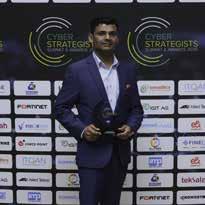



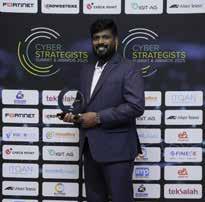
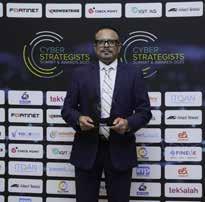

Federal Authority for Nuclear Regulation

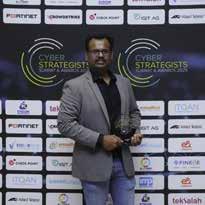
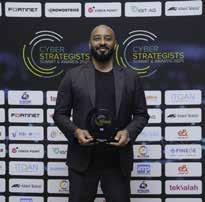
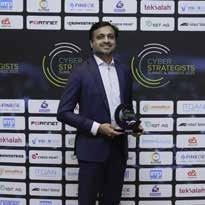

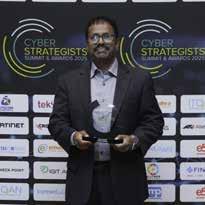






















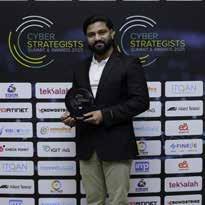









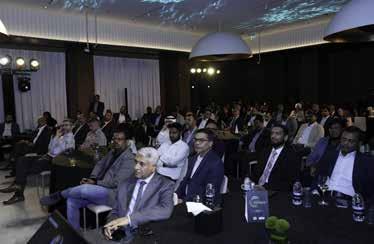




Mohammad Amin, Senior Vice President – CEEMETA, Dell Technologies, shares insights into the region’s AI momentum, the importance of purposeful implementation, and the responsible advancement of the technology
Saudi Arabia and the UAE are making significant investments in AI and data sovereignty. How is Dell aligning with these national agendas, and how do your recent announcements support these objectives?
We’re very involved in what’s happening across the region, including the recent high-profile visits and discussions. While I can’t disclose specific deal details yet, I can say we are closely engaged, and some major agreements are already in motion.
The AI momentum in Saudi Arabia and the UAE is exceptional. For example, the UAE is now the third-ranked country globally for AI, after the US and China. This isn’t a reactive movement—it’s part
of a well-though out strategy. The UAE was the first country in the world to appoint a Minister of AI and that shows long-term vision and commitment to AI leadership.
AI follows energy, and the Gulf region has energy. That naturally makes us a central hub for AI. At Dell, we’ve had a strong presence in Saudi and the UAE for years, holding leading market share and maintaining close relationships with both governments and major players like G42.
What kind of traction are you seeing for Dell’s AI Factory in the region, and which sectors are driving adoption?
This Middle East is one of Dell’s best-performing markets globally for AI Factory adoption. Over the past year, hundreds of customers across the Middle East have embraced the platform.
There’s strong urgency—everyone wants to implement AI, but many don’t know how. That’s where we come in. It’s about identifying the right use cases and guiding organisations through meaningful deployment.
Government bodies, the banking sector, and logistics are leading adoption. Digital twin technology is a particularly strong use case— allowing organisations to simulate operations, speed up time to market, and sharpen competitiveness.
How do you support organisations that struggle with implementing AI meaningfully?
At Dell, we never do anything just for the sake of it. Our mission is to enhance human progress, and we live by that. Once we understand a customer’s business and identify the right use cases, implementation becomes the easiest part. A bank, a government, a hospital, or a university—they all require different approaches. That’s why we take the time to study their environment and ensure AI is applied with purpose, not just as a checkbox.
Ethical considerations are also among the most important aspects to address in the AI conversation.

The truth is, any rules you create for AI today might be irrelevant within a year. The technology is evolving so quickly that rigid control could actually slow down meaningful development. Globally, there are two camps—one that believes in tightly regulating AI and its ethics, and another that supports unleashing it and adapting as it progresses. Personally, I lean more towards the latter. I believe in unleashing AI—but doing so responsibly.
And this is where data becomes absolutely essential. Responsible AI doesn’t start with regulation—it starts with the data you feed into it. If the data is unclean, unstructured, or misaligned with your values, then the outcomes will be flawed, no matter how ethical your intentions.
How do you see the future of AI evolving?
Things are moving incredibly fast. We’ve already seen the evolution from traditional AI to generative AI, and now to agentic AI. Not long ago, AI could assist you in writing a CV. Today, agentic AI can go far beyond that—it can write the CV, apply for the job, schedule the interview, and even coach you on how to prepare. AI is becoming an autonomous agent that can carry out entire tasks on your behalf.
Our mission is to enhance human progress, and we live by that
People are already talking about what comes next—Organoid Intelligence, or OI—which involves combining silicon with live human brain cells. That might sound like science fiction, but it’s not. The first prototypes already exist, and brain cells have been donated for this kind of research. It’s a new class of computing that blends biological cognition with machine processing. That kind of advancement could be incredibly powerful—and yes, it’s a little scary.
But I’ve learned that when something scares you, the best thing you can do is become part of it. You can’t stop these advancements, so it’s better to engage, contribute, and help shape the future.
What is Dell’s long-term vision for the region?
Our vision is to help the Gulf stay at the forefront of the digital economy. This region has the energy, the data, and the financial strength. But more importantly, our focus is to ensure that our customers are successful –when they succeed, we succeed.
If I walk into a C-level meeting and talk only about infrastructure, it’s a five-minute conversation. But when I talk about how our technology can future-proof their business, that’s where the real dialogue happens. Change is inevitable—and history proves it. Around 90 percent of the Fortune 500 companies from 1980 no longer exist today, simply because they failed to read the future and adapt in time. At Dell Technologies, our mission is to help organisations avoid that fate. We’re committed to helping them become part of the future, so they can evolve and stay competitive.


By Krishna Sai, Chief Technology Officer, SolarWinds
Across the Middle East, governments and enterprises are pushing ahead with unprecedentedly ambitious AI strategies. From Saudi Arabia’s Saudi Vision 2030 to the UAE’s National Strategy for AI, the mission is bold: to become global leaders in AI innovation. Yet, behind these national roadmaps, thousands of IT professionals are quietly powering the digital backbone of organisations. For many, their day-to-day is far less about shaping the future and more about keeping the lights on. For the average IT engineer, the goals are simpler and more grounded. They want their systems to run smoothly, fewer 3 a.m. phone calls about outages, and more
time to fix root problems rather than patch the symptoms. They care about productivity, uptime, and not being the last person in the office every night. In this context, generative AI (GenAI) has a human role, not as a threat, but as a powerful co-collaborator that makes running IT services more manageable and rewarding.
Imagine a typical day for an IT administrator at a midsize organisation in Dubai or Riyadh. The day starts with an overflowing ticket queue—password resets, printer issues, permission changes, a handful of service outages, and an inbox full of monitoring alerts that may or may not indicate something serious. By 10 a.m., the administrator

GenAI doesn’t replace the human touch; it elevates it
GenAI offers a way forward. By automating routine service desk tasks—triaging tickets, categorising incidents, and handling common requests—GenAI reduces noise and creates breathing room. It can also analyse historical data to predict recurring issues and proactively suggest fixes, helping IT teams shift from reactive firefighting to strategic foresight. With the right tools, an admin could proactively start their day with a concise summary of key issues and intelligent recommendations, providing the headspace to focus on improvements instead of maintenance.
While larger enterprises have traditionally had the resources to invest in robust ITSM systems and dedicated teams, small and mediumsized enterprises (SMEs) often make do. And yet, SMEs form the backbone of the region’s economy. In the UAE, SMEs account for over 94 percent of all companies and employ more than 86 percent of the private sector workforce. In Saudi Arabia, the Vision 2030 initiative aims to increase SME contribution to GDP from 20 to 35 percent by the end of the decade.
When SMEs succeed, economies thrive—but to succeed in the digital age, they need access to scalable, intelligent IT support that doesn’t require an army of experts. This is where GenAI-enhanced ITSM platforms become game-changers. Suddenly, small and mid-sized businesses (SMBs) can tap into the insights, analytics, and automation capabilities once reserved for Fortune 500 companies.
questions about job security. But within the realm of ITSM, the story isn’t one of replacement—it’s one of relief. Processing thousands of logs, triaging endless alerts, or manually tracking configuration changes is more than tedious; it saps morale, breeds dissatisfaction, and accelerates churn.
GenAI doesn’t replace the human touch; it elevates it. AI excels at pattern recognition, speed, and scale. But it lacks the contextual awareness, intuition, and empathy seasoned IT professionals bring. By handing over the grunt work to AI, organisations can empower their staff to focus on higher-value tasks—architecting solutions, solving business problems, or simply spending more time with their families.
GenAI’s collaborative model helps companies retain talent, reduce burnout, and keeps IT teams engaged, valued, and strategically aligned with organisational goals.
The timing couldn’t be more critical. As regional governments pour billions into AI infrastructure and skills development, enterprises are under pressure to modernise and automate. According to a PwC report, AI is expected to contribute up to US$320 billion to the Middle East economy by 2030. But this growth won’t be driven by moonshot ideas alone—it will come from practical, everyday applications of AI that improve how businesses operate behind the scenes.
has already skipped breakfast, missed a call from home, and put their planned infrastructure project on hold... again.
This constant firefighting leaves little room for strategic thinking or meaningful innovation. Burnout is a growing concern among IT staff, who often feel undervalued despite being crucial to their roles.
SMBs can identify root causes of recurring problems, streamline workflows, and support lean IT teams without excessive cost or complexity. The people behind these businesses can spend time supporting customers, innovating products, and growing operations, instead of being on hold with tech support.
Of course, any conversation about AI and automation comes with
GenAI in ITSM is an application that directly impacts efficiency, resilience, and service quality. It improves the lives of the people running IT operations daily—those who rarely feature in national strategies but without whom digital transformation would halt.
For IT leaders in the Middle East, now is the time to reframe GenAI as an ally. It serves as a lifeline for overworked teams, not as a threat to jobs. It’s a practical step to building more innovative, humancentred IT organisations. When AI works for people and processes, everyone wins.

IBy Greg Pada, SVP, Head of Engineering Business, AVEVA
n a world of rising geopolitical tensions and unpredictable politics, the global economy is braced for constant, sudden change. The current US administration has introduced unprecedented tariffs, with more in the pipeline, shaking up international material deliveries and supply chains.
This shift in world order will profoundly affect Engineering, Procurement, and Construction (EPC) businesses, given their natural dependence on long leadtime global components within tight timeframes. EPCs also face mounting pressures from rising costs, skilled labor shortages, and sustainability mandates.
Amid these high-pressure variables and moving parts, companies must remain agile and flexible to complete projects on time and within budget.
Although modern technologies can go some way to mitigate the unpredictability of policy shifts and budget constraints, the traditionally conservative EPC industry has been slow to embrace digital transformation.
In today’s volatile climate, digitalisation is no longer optional for EPCs – it’s a strategic necessity.
The challenges faced by EPCs are myriad, time-sensitive, and increasingly complex.
Fragmented project execution often leads to inefficiencies and costly rework, while volatile supply chains can derail material procurement and extend project timelines. In addition, a shortage of workers puts stress on knowledge retention and jeopardises project continuity.
The industry is also beset with outdated legacy technology, which can significantly impair collaboration and hamper effective decisionmaking. What’s more, siloed systems hinder connectivity, visibility and transparency – the lifeblood of AIenabled, high productivity solutions.
The good news is that embracing technology can significantly mitigate EPC hurdles. McKinsey reports that implementing digital tools can boost productivity by 14-15 percent, while reducing costs between four to six percent.
Digital transformation can tackle entrenched EPC challenges, enabling firms to build critical resilience and agility.
In the first instance, cloud-based technologies are transforming the way engineering teams collaborate. By unifying engineering processes and enabling collective project execution, firms can break down geographical and organisational barriers. This radical collaboration accelerates decision-making and streamlines workflows, ensuring

project teams are more responsive and better equipped to manage complex tasks.
In addition, automation, infused with AI, is transforming the EPC landscape.
AI-powered tools enhance engineering precision, reducing the risk of rework and curbing unforeseen costs. By streamlining routine processes and offering data-driven insights, these
14–15%
The rate at which productivity can increase with digital tool adoption
Source:McKinsey

technologies boost efficiency and free up valuable human resources for more strategic tasks.
Collaborative gains from digital twins
With an integrated engineering workflow, EPCs can create a digital twin of their projects that spans the design, engineering and handover stages. Digital twins are real-time virtual representations of physical assets, processes, or environments that look like and behave like their real-world counterparts. They allow EPC firms to simulate, predict, and optimise project performance.
By combining engineering and operations data from across the engineering lifecycle and enhancing it with first-principles modeling and AI-infused analytics, digital twins can give teams in-depth industrial intelligence around value and sustainability.
The power of a digital twin can be seen clearly in its demonstrable cost savings. For instance, McKinsey projects that implementing digital twins can generate up to operational expense reductions of up to 20 percent.
After project handover, digital twins can also provide major benefits to EPC clients during the operations and maintenance (O&M) phase. Digital twins ensure that end-users don’t just receive a static asset but gain a living, evolving digital model that supports long-term performance, lower total cost of ownership and extended asset lifespan.
As such, EPC companies are increasingly asked by their clients to provide a digital twin for smoother handover and optimised operations – a win-win scenario for all stakeholders.
The practical benefits of digital transformation are already evident in the EPC world.
Aberdeen-headquartered Wood, for example, has seamlessly integrated capital project engineering and execution data to enable its teams to openly and flexibly collaborate.
By improving collaboration, the company has expedited execution cycles and sped up build processes.
Wood has also generated significant cost savings by standardising materials and streamlining design processes.
With the development of its Digital Control Tower, Wood teams use digital twins to more efficiently use materials and plan construction. In-house pattern recognition software can predict project delays and ensure performance stays on track.
In India, L&T Hydrocarbon Engineering, has taken a major digital step through boosting collaboration and insight during a critical handover for the nation’s largest crude producer, Oil & Natural Gas Corporation (ONGC).
L&T, which specialises in upstream EPC projects for the oil and gas industry, had already seen the benefits of ONGC’s data-centric approach to project handover, which is why the company began its own initiative to define and implement a single-point repository of data.
At the same time, the project sped up communication and decisionmaking, seamlessly integrated 3D models and engineering data, and enabled efficient online search for faster navigation, querying, sorting, consolidation, and reporting.
The result was a highperformance handover solution which united many different data sources to better meet the needs of India’s largest crude oil producer.
Forward-thinking EPCs that embrace digitalisation will empower their teams with the agility and flexibility essential for thriving in volatile conditions.
In this way, EPCs can turn operational challenges into strategic opportunities by harnessing cloudbased collaboration, AI-driven automation, and digital twins.
Faster project execution, enhanced teamwork, and tangible cost savings are all within reach with currently available technologies. The EPC companies that thrive in today’s dynamic new world order will be those who have the adaptability to do so.
Daljeet Singh, Co-Founder & Director of Business Development, iConnect IT Business Solutions, shares insights into how managed services are powering UAE enterprises

In today’s hyper-connected economy, the pressure on organisations to remain secure, agile, and digitally mature has never been higher. According to IDC, IT services spending in the UAE is projected to reach $3.02 billion by 2025, with managed services making up nearly 30 percent of this investment.
As enterprises across the UAE accelerate their digital transformation—adopting hybrid cloud environments, deploying AI, and navigating compliance frameworks— the need for expert-managed infrastructure and operations has become a strategic priority.
“Managed services were once seen as back-office support,” said Daljeet Singh, Co-Founder & Director of Business Development, iConnect IT Business Solutions. “But the rapid pace of digital transformation has made it difficult for organisations to manage complex IT environments on their own.”
What was once a cost-saving measure is now a strategic lever for innovation and resilience. Enterprises increasingly seek MSPs who can deliver outcomes that are aligned with their business goals—not just technical support. “They are seen as strategic partners who help businesses innovate, stay secure, and respond quickly to change,” explained Singh.
A key area where managed services have become especially valuable is cybersecurity. As organisations scale, their risk surface expands— creating new vulnerabilities across cloud environments, endpoints, and applications. This is evident in the sharp rise in cyber threats across the Middle East, which accounted for 10 percent of global attacks in 2024—up from seven percent the
previous year—with Saudi Arabia and the UAE emerging as primary targets, according to the IBM X-Force Threat Intelligence Index 2025.
“Managed security services help organisations build resilience by providing dedicated security experts who become a core part of their security function,” said Singh. “These professionals bring extensive cybersecurity knowledge and experience, ensuring businesses meet compliance requirements effectively.”
According to Singh, iConnect delivers this resilience by combining deep cybersecurity expertise with a commitment to staying ahead through continuous learning and the latest technologies. “Using the right and leading technology solutions is equally important to stay ahead of evolving threats,” he added.
“At iConnect, we stay continuously updated with the latest market developments and receive regular training directly from solution providers whenever new updates or technologies emerge.”
This proactive approach ensures iConnect clients benefit from the most current and effective security controls—reducing risk, supporting compliance, and enabling confident growth.
With experience across more than 200 Middle East enterprises, iConnect has developed tailored approaches for key sectors. “For government, data sovereignty and strict compliance with local laws are key. In BFSI, fast response, accuracy, and strong data protection matter most. Healthcare requires high system availability and patient data privacy. Our approach is always customised, blending industry knowledge with flexible technology,” said Singh.
Emerging technologies like AI and automation have reshaped managed services—transforming how support is delivered, issues are detected, and performance is optimised. “AI can now automate many routine tasks such as threat detection, incident response, and system monitoring,” said Singh. “This shift allows managed service providers to move from

Our mission is to enhance human progress, and we live by that
reactive problem-solving to proactive management, predicting issues before they impact business.”
For clients, this means faster response, reduced downtime, and more efficient IT operations. It also enables providers like iConnect to scale support rapidly while maintaining service quality.
Measuring ROI and what’s next The value of managed services is now being measured through the lens of business impact rather than operational savings. While cost control remains important, enterprises are prioritising outcomes like enhanced security, faster incident response, and sustained uptime.
“Some clients measure ROI through efficiency gains, others through stronger threat protection,” explained Singh. “Preventing a breach that could have cost millions is a value that isn’t always visible but is absolutely critical.”
This shift reflects a broader redefinition of ROI—recognising the cost of inaction, reputational risks, and the advantage of agility. For iConnect, delivering ROI means translating technology investments into resilience, scalability, and peace of mind.
Looking ahead, the managed services market in the UAE is expected to move decisively toward strategic, value-led engagements. Enterprises are no longer looking for vendors—they want partners who can anticipate challenges, deliver innovation, and align with long-term goals.
“At iConnect, we focus on investing in the right platforms, building deep industry capabilities, and expanding our focus on cybersecurity and automation,” the executive shares.
“We also ensure our teams are continuously trained on new technologies and real-world use cases. It’s not about reacting to demand—it’s about being ready before it arrives.”


By David Boast, General Manager – UAE & KSA, Endava
Core modernisation is no longer a question of if, but when. Enterprises across industries are grappling with the realities of legacy systems that, while once the backbone of operations, are now slowing down agility, innovation, and scalability. But as necessary as modernisation is, it’s also a daunting undertaking—one that carries risks ranging from operational disruption to spiralling costs and integration challenges. The good news is that modernisation doesn’t have to be a high-stakes gamble. With the right strategy, it’s possible to transform core systems while maintaining business continuity,

managing risks effectively, and ensuring that the investment pays off in real, tangible value.
The first step is understanding what you’re working with. Before any modernisation effort begins, an organisation needs a clear picture of its existing core systems, infrastructure, and business processes. Too often, enterprises dive into transformation projects without fully grasping how their legacy systems function, where inefficiencies exist, and what dependencies could complicate integration. A deep assessment of the current environment— spanning technical architecture, business workflows, and data structures—creates a foundation for smarter decision-making. It’s about identifying what to keep, what to change, and what to retire, ensuring
No modernisation project exists in a vacuum—market conditions shift, customer expectations change, and new technological capabilities emerge
that modernisation efforts don’t inadvertently break what’s already working.
Once there’s clarity on the current state, the focus shifts to defining a modernisation strategy that delivers continuous value. The most successful transformations aren’t those that attempt a massive overhaul in one go, but rather those that take an incremental, carefully phased approach. Rather than aiming for an end-state that could take years to realise, businesses should focus on delivering value at every stage of the journey. This means adopting an agile mindset, where modernisation efforts are rolled out in stages—each phase stabilising and proving its worth before the next step begins. It’s a way to maintain flexibility, minimise disruption, and ensure that the system evolves in line with real business needs rather than rigid long-term plans.
There’s also a fundamental balancing act that comes into play when designing a modernisation roadmap. Every decision involves trade-offs—whether it’s performance versus security, flexibility versus complexity, or cost versus scalability. The key is determining which attributes are essential for the longterm sustainability of the system. A future-ready enterprise core isn’t just one that meets today’s needs; it’s one that can adapt to future changes in business models, regulatory requirements, and technology landscapes. Designing for flexibility from the outset ensures that modernisation isn’t something that needs to be revisited every few years, but instead becomes an ongoing, adaptive process.
Execution models and accelerators: Driving efficiency with AI and automation
Of course, even the best-laid plans can be derailed without the right execution model. The real challenge of modernisation isn’t just knowing what needs to be done—it’s
ensuring that the process is efficient, transparent, and minimises business risk. The traditional approach to system transformation often relied heavily on manual processes, extensive documentation, and timeconsuming change management. But today, with AI and automation, modernisation can be executed in a way that significantly reduces risk and effort.
Modern delivery teams now have access to accelerators that enhance decision-making and streamline the execution of change. AI-powered tools, like Endava’s Compass, that act as virtual subject matter experts can provide on-demand insights and guidance—supporting teams as they navigate complex environments and make critical system changes with confidence. This shift not only reduces dependency on static documentation but also empowers transformation teams to move faster, while minimising operational risk. An agile, iterative execution model also allows for continual reprioritisation as business needs evolve. No modernisation project exists in a vacuum— market conditions shift, customer expectations change, and new technological capabilities emerge. By adopting a flexible, data-driven approach, organisations can ensure that transformation efforts remain aligned with strategic goals, rather than getting locked into outdated plans that no longer serve the business.
Ultimately, successful modernisation isn’t just about upgrading technology—it’s about creating a foundation for business agility and innovation. Organisations that approach transformation with a clear roadmap, a focus on delivering continuous value, and an execution model that prioritises efficiency and risk management will be the ones that see the greatest long-term benefits. Modernisation done right isn’t just about catching up with today’s demands; it’s about setting the stage for future growth and resilience.

ABy Kevin Miller, CTO, IFS
s the AI landscape rapidly evolves, business and technology leaders face growing challenges in balancing immediate AI investments with long-term sustainability objectives. In the rush to adopt AI, many businesses neglect this balance, prioritising short-term gains over sustainable practices – a trend that can negatively impact both the environment and the economy. There’s a clear correlation between sustainability planning and overall AI optimism, as countries with less comprehensive AI sustainability strategies, such as the UK (5 percent), Canada (6 percent), Denmark (6 percent), and Finland (4 percent), are also among the least optimistic about AI’s potential.
To address the pressing need for sustainable innovation, they must implement strategies that align AI advancements with long-term sustainability goals. Focusing on solutions that offer longevity and adaptability enables businesses to avoid the pitfalls of unsustainable AI practices, ensuring that their investments contribute to a more sustainable future.
By adopting strategies that emphasise sustainable AI practices, companies can mitigate the risks
associated with short-term thinking. For example, they can invest in AI systems that are energyefficient, scalable, and capable of evolving with technological advancements. Additionally, integrating sustainability metrics into AI development and deployment processes can help organisations track their progress and make informed decisions that support long-term objectives.
Getting ahead of the competition
Early and strategic adoption of AI gives organisations a clear advantage, positioning them as leaders in both innovation and sustainability. By integrating AI with sustainability from the outset, these pioneers set industry benchmarks and influence how competitors shape their strategies. They gain immediate benefits—like improved efficiency and cost savings—while aligning with long-term global sustainability goals.
The success of these early adopters demonstrates how innovation and environmental responsibility can go hand in hand. This approach boosts brand reputation and attracts customers and partners who value sustainability. As more businesses
follow suit, early adopters will be better positioned to lead, adapt to new trends and regulations, and set industry standards.
Ensure efficient and sustainable resource utilisation starts with prioritising solutions that offer longevity and adaptability. Foundational technologies like remanufacturing help reduce waste and improve competitiveness in a circular economy. Regular maintenance and thoughtful deployment extend product value.
Yet the fast pace of AI development presents risks. Technologies can quickly become obsolete due to “Shiny Object Syndrome”—adopting trends without assessing long-term value. Many AI tools are standalone and hard to integrate. Frequent updates, such as those from ChatGPT, can render systems outdated. Leaders must ensure AI investments align with long-term goals and enterprise architecture.
To avoid wasted investments, companies need to ensure that each investment supports future growth and environmental responsibility, as sustainable AI investments require long-term vision. This involves evaluating the lifecycle, resource impact, and energy consumption of AI technologies. Responsible deployment and governance are essential.
Due to their energy-intensive nature, AI systems can raise carbon footprints and generate e-waste. A full-lifecycle assessment—from development to deployment—is key to minimising environmental impact and ensuring future-ready, responsible innovation.
Clear metrics for return on investment (ROI) are essential for sustainable AI adoption. Businesses must establish frameworks to evaluate both financial and environmental outcomes, ensuring investments support innovation and align with sustainability goals.


Balancing short-term AI gains with long-term sustainability requires a strategic approach. This includes aligning stakeholder goals and creating a data strategy that spans both cloud and onpremise environments. While cloud solutions offer flexibility, they may result in high costs and vendor lock-in. Conversely, on-premise infrastructure can cut costs but may raise energy use and emissions. Adopting an industrial AI strategy and evaluating the full lifecycle of investments ensures AI supports sustainable operations.
AI is not just a driver of innovation— it also enables sustainability. From optimising energy consumption to improving resource management, AI helps reduce waste and environmental impact. For example, predictive maintenance powered by AI extends the life of
equipment, reducing replacements and emissions. Tools that enable sustainability reporting also support broader environmental efforts.
With the right technology and insights, organisations can showcase how their historical practices reflect sustainable and responsible choices.
Leaders who align AI with sustainability can manage complexity while gaining a competitive edge. These practices improve efficiency, build resilience, and strengthen brand value. In an era of eco-conscious consumers and increasing regulatory scrutiny, sustainability becomes a key differentiator.
Sustainability should be an integral part of AI strategy, not a separate initiative. By aligning AI investments with sustainability goals, businesses can drive innovation that is both cuttingedge and responsible. This holistic approach ensures that
Technologies can quickly become obsolete due to ‘Shiny Object Syndrome’—adopting trends without assessing long-term value
AI technologies contribute to a sustainable future, one where companies thrive by advancing technologically while championing environmental stewardship. Those who integrate these principles into their AI strategies will be best positioned to lead, setting new standards for innovation, sustainability, and long-term success.


ASunil Paul, MD, Finesse, reflects on the collapse of Builder.ai and why it serves as a wake-up call for tech leaders to not to get swept up in the AI gold rush
rtificial intelligence has become the crown jewel of tech ambition, and with it comes a rush of startups eager to capitalise on its promise. But in a market where perception often moves faster than proof, the line between innovation and illusion can blur dangerously. Few stories highlight this better than the rise and fall of Builder. ai—a company that sold a vision of AI-powered software development, only to be undone by the realities behind its pitch.
Positioning itself as a gamechanger in the no-code space, Builder.ai claimed that it could make building custom apps “easy as buying a pizza”. Its AI assistant,
Natasha, was billed as the brains behind the operation—automating complex development tasks through smart algorithms. The promise resonated with investors, drawing over $445 million in funding and earning backing from the likes of Microsoft and the Qatar Investment Authority. By 2023, the company had reached a valuation of $1.3 billion, riding high on AI hype. But beneath the surface, things looked very different. Investigations revealed that the platform was powered not by advanced AI, but by hundreds of engineers in India, manually executing tasks that users believed were being handled by automation. Described internally as “human-assisted
AI,” the gap between perception and reality became increasingly difficult to defend.
The financial picture was no better. Builder.ai was accused of inflating its revenue using questionable accounting methods, including allegedly recycling money through partner firms to pad its numbers. Internal audits reportedly cut previously stated revenue figures by over 75 percent. When a lender froze $37 million in funds, the company was unable to meet its obligations. In May 2025, it filed for insolvency, with legal scrutiny and proceedings unfolding across multiple jurisdictions. Reports say US authorities are now investigating possible fraud.
The fall of Builder.ai is a stark reminder that while AI is transforming industries, genuine transformation demands accountability. Hype may win headlines and funding rounds, but innovation cannot come at the expense of transparency. As the industry continues to evolve, it must do so with a greater commitment to substance over spectacle—because in the end, credibility, not code, is what separates the lasting from the fleeting.



HONOR has launched its new 400 Series smartphones in the Middle East and Africa, introducing two new models— HONOR 400 and HONOR 400 Pro.
Both models feature a 200MP Ultra-Clear AI Camera system. The Pro version supports up to 50x zoom, while the standard model offers 30x zoom. The devices also include an AI Creative Editor that enables users to transform photos into short videos, erase passers-by from crowded backgrounds, upscale old images, and apply advanced
editing tools such as AI Eyes Open and AI Remove Reflection. Running on MagicOS 9.0 based on Android 15, the HONOR 400 Series includes real-time speechto-text subtitles, device syncing across Android and iOS, and AI-powered translation tools. The Pro variant is equipped with a 6000mAh battery and supports 100W fast charging. It is also rated IP68 and IP69 for water and dust resistance.
Both are available for pre-order across major retailers in the UAE, with extended software support promised through 2030.

Intel has debuted its new Arc Pro B-Series GPUs at Computex 2025, expanding its professional graphics lineup with the Arc Pro B60 and B50. Built on the company’s next-generation Xe2 architecture, the GPUs are designed for AI inference, professional content creation, and engineering workflows.
The Arc Pro B50 is a low-power, dual-slot card with 16GB of GDDR6 memory and a power draw under 75W, making it suitable for compact workstations. It includes 16 Xe cores and 128 AI-accelerating XMX engines. Intel claims the B50 delivers up to 3.4x better performance than its predecessor in AI and graphics tasks, while offering higher memory capacity than competing products in its class.
The higher-end Arc Pro B60 steps up to 24GB of GDDR6 memory, 20 Xe cores, and 160 XMX engines. With up to 200W power draw, it’s intended for heavier AI inference tasks and supports dual-GPU configurations, making it suitable for handling large language models.
Both GPUs support real-time ray tracing and are compatible with Windows and Linux environments.

Synology has unveiled the PAS7700, marking its entry into high-performance enterprise storage with a fully NVMe, activeactive architecture. Designed for mission-critical environments, the PAS7700 features dual controllers and a non-disruptive failover system to ensure uninterrupted service.
The system uses an end-toend NVMe design to deliver up to 2 million IOPS and submillisecond latency, significantly improving performance over previous Synology models—by
as much as three times. Built for high availability, the dualcontroller configuration allows for system maintenance without affecting uptime, making it suitable for sectors such as finance, healthcare, and AI where reliability is critical.
One of the key features of the PAS7700 is its integrated 3-2-1-1 backup approach, which includes support for on-site, off-site, and immutable backups. This adds a layer of data resilience that aligns with enterprise-grade disaster recovery requirements. The storage system also incorporates security protections at both the hardware and software levels.

